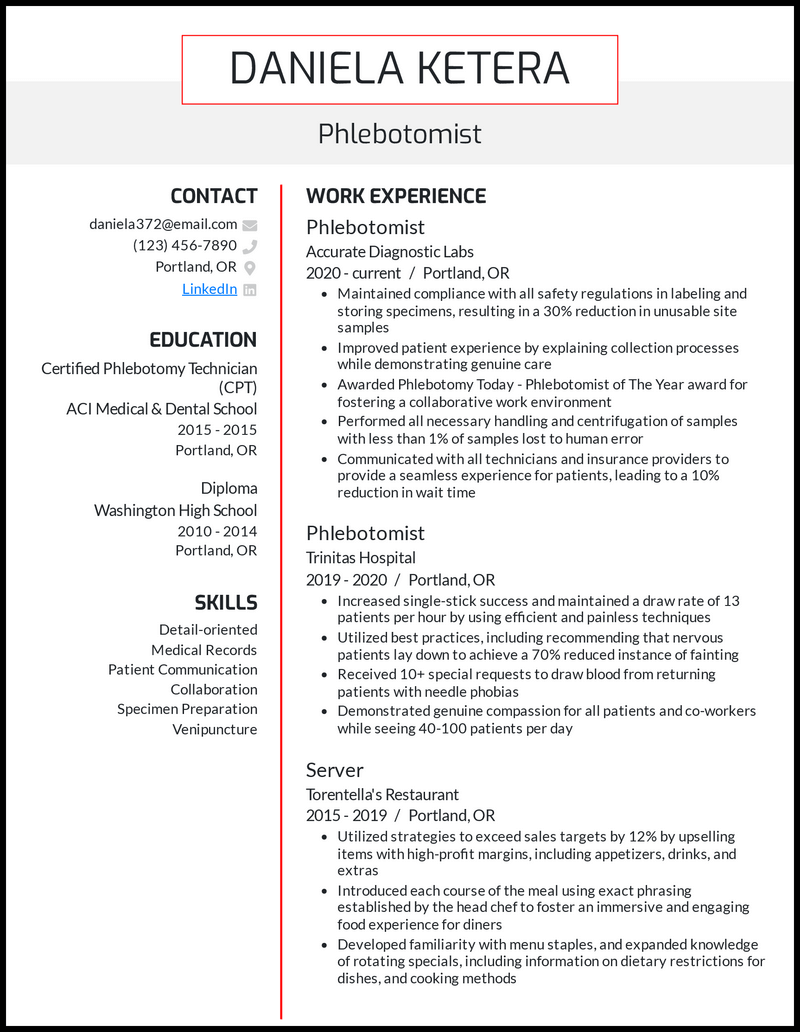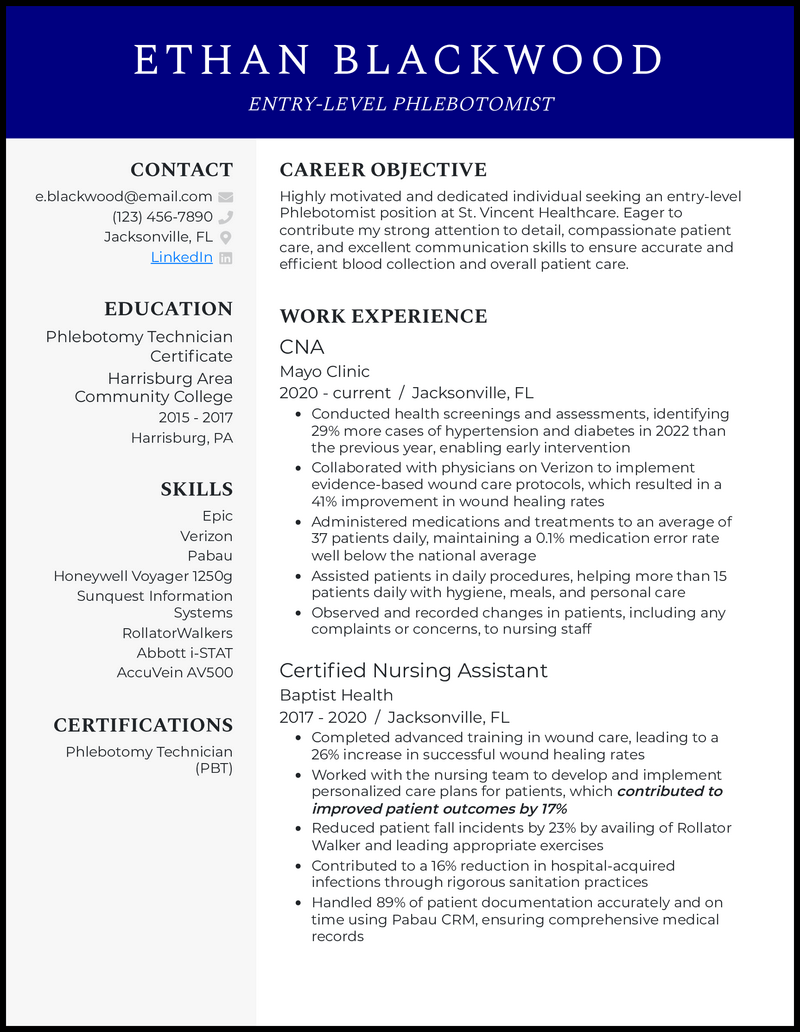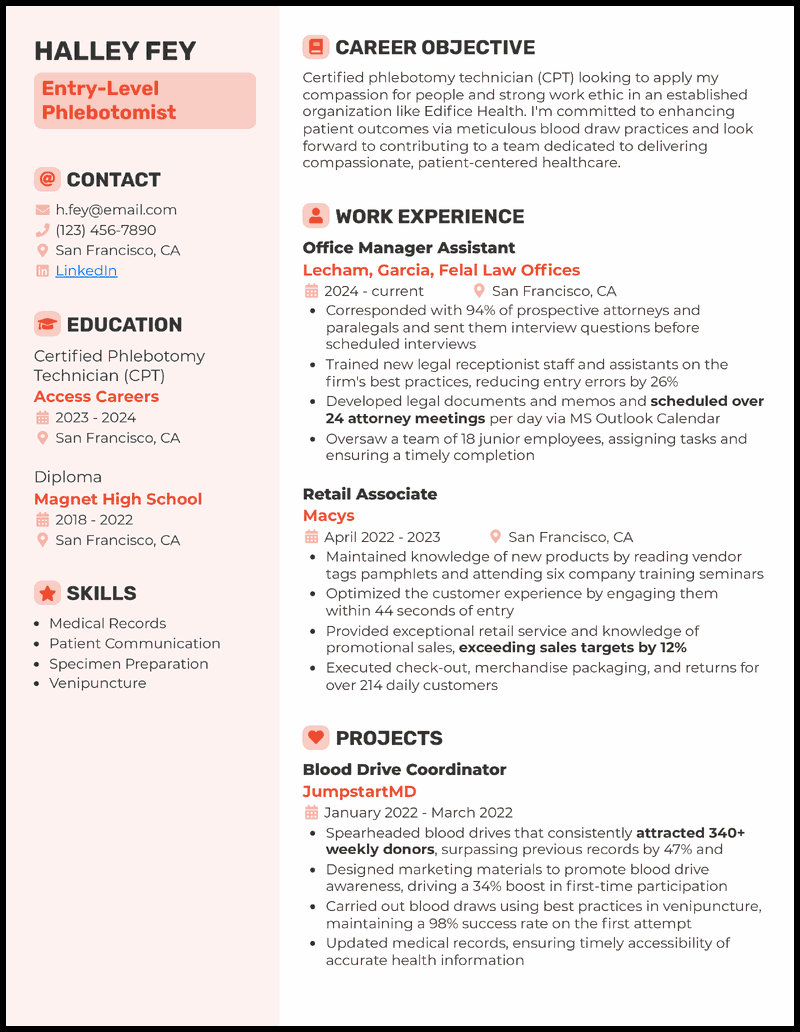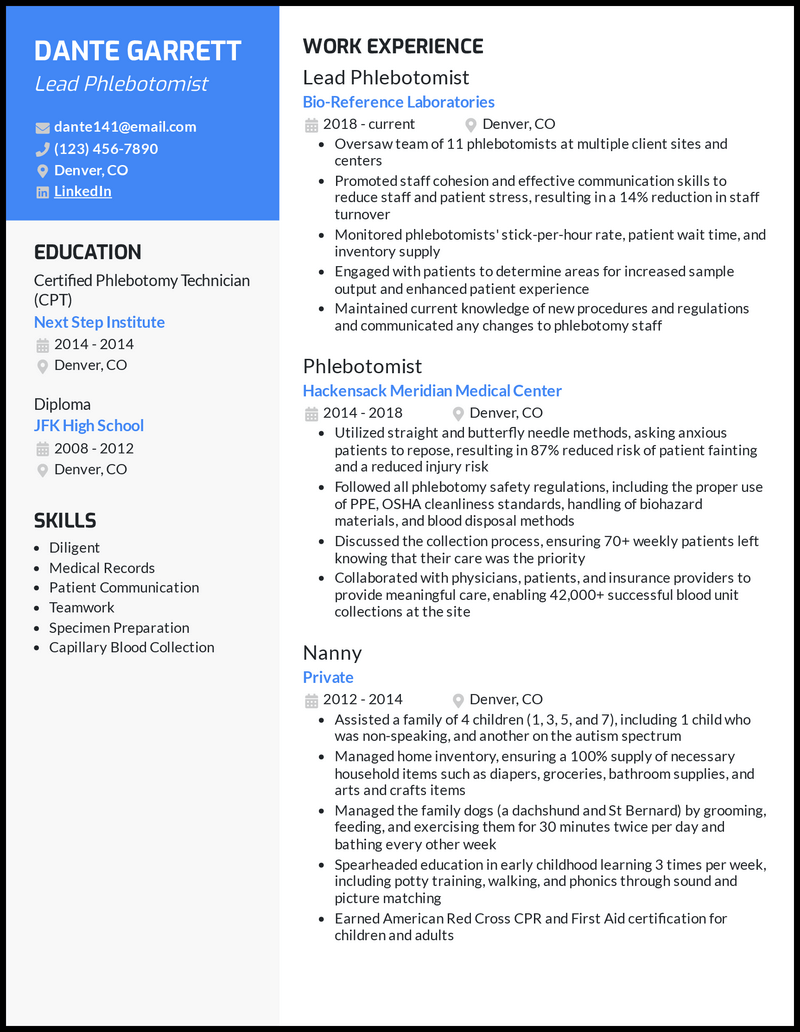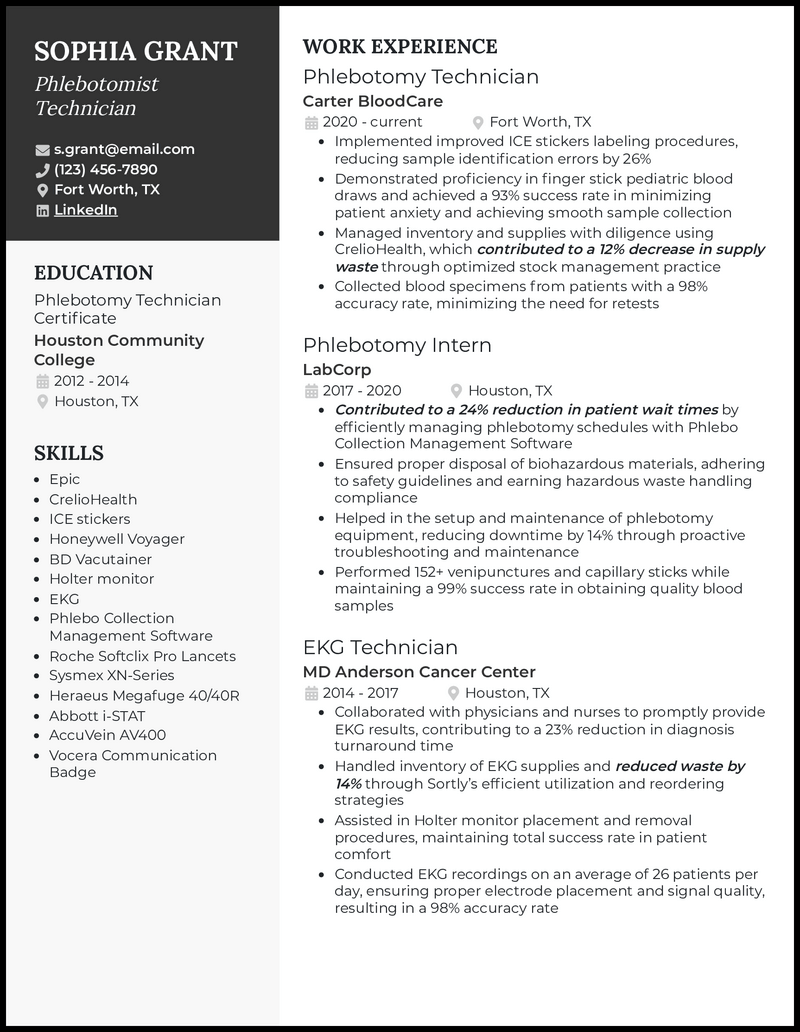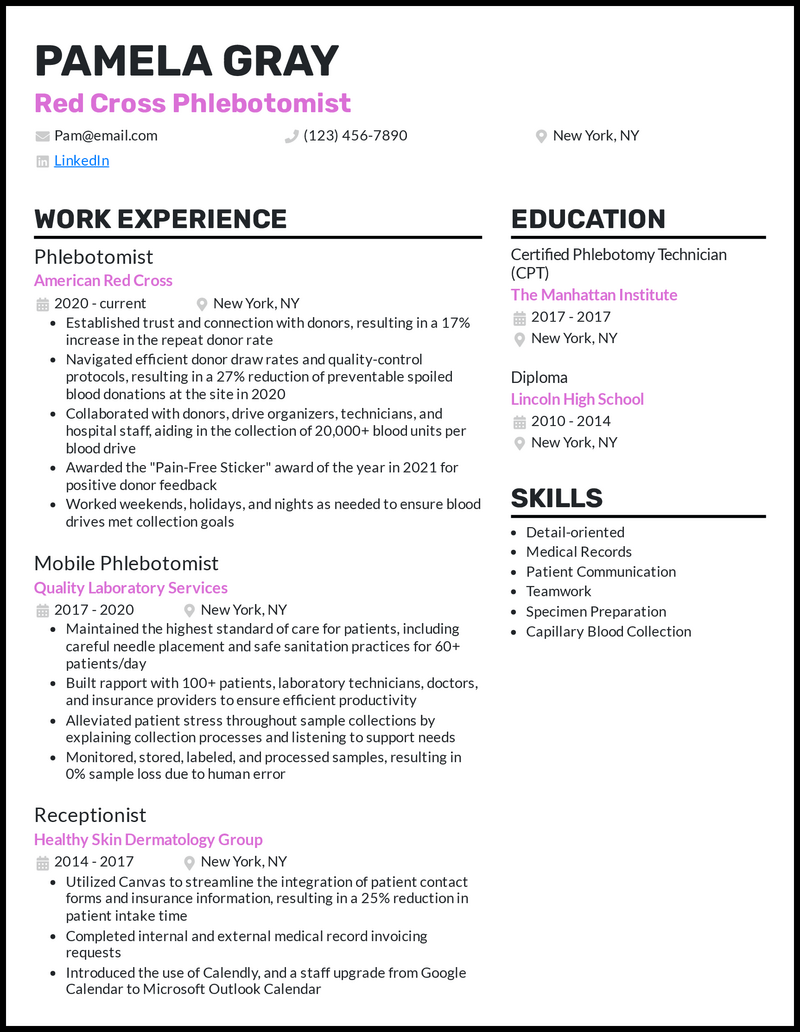Whether you’re a lead phlebotomist or you’ve just gotten your CPT certification, it can be challenging to convey your experience on a resume in a way that impresses potential employers.
To be a successful phlebotomist, you need to have mastery of many skills. You must be empathetic, detail-oriented, a team player, and possess specialized training.
Conveying this information in a professionally-formatted resume or via a cover letter generator shouldn’t be your job.
That’s why we analyzed numerous phlebotomist resumes to determine which ones generate the most interviews. We’ve refined our analysis to the top 19 phlebotomist resume samples to get your dream job in 2025.
We’ll also share the best resume tips from our research to help you stand out.
Why this resume works
- When you quickly glance at your phlebotomist resume, what should stand out? The numbers. Quantifying your accomplishments encourages hiring managers to slow down and take a second look, which is important because, on average, they’ll only spend six seconds looking at your resume.
- Your resume should be packed with information and key takeaways with highly specific, relevant bullet points to what a potential employer wants in an ideal phlebotomist.
- If you have unrelated work experience, highlight related soft skills from that position, like teamwork, which is a key skill that lands interviews.
- The skills section is the second most important on your entire resume because it determines whether a hiring manager even sees your resume. Take time to read the most important resume skills for your resume.
Why this resume works
- Highlighting your ability to work with diverse teams of experts will give your new phlebotomist resume a good headstart. You can then dive into how your valuable input led to improved patient outcomes.
- Also, don’t forget to show how you facilitated patient education to ensure quick recovery rates at homecare settings and an overall reduction in readmissions.
Why this resume works
- Maybe you’ve just completed your certification and are looking for your first full-time phlebotomy position. Mentioning key phlebotomy skills throughout your entry-level phlebotomist resume helps make the case that you will be excellent on the job.
- Your resume should demonstrate skills including patient communication, organization, customer service, interpersonal skills with coworkers, and attention to detail. These are necessary skills for any prospective phlebotomist.
- Remember, a prospective employer can readily train you in operating procedures, but they can’t easily teach you to be an empathetic team member.
- Including a resume objective isn’t always necessary but may be helpful if you’re changing career paths or are light on experience. Resume objectives require specifications for each job to which you apply. Match keywords in your objective to the job description.
Why this resume works
- So, your experience is as good as only a few drops of blood? Keep your chin up. A student phlebotomist resume highlighting your wins during relevant volunteering stints can see you outshine those 50+ experienced applicants you’re up against.
- For example, don’t think twice about recounting that time you trained up to 6 new volunteers in blood drawing techniques—it says you’re a leader, and recruiters have a thing for your kind.
Why this resume works
- Sure, you’ve only been in the game for a while. However, that doesn’t mean your phlebotomy intern resume deserves space in the large “Trash” pile on the hiring manager’s desk. Ready to prove it? Show that you’ve met one or two requirements for the role.
- For instance, phlebotomists must be super careful and always on the ball to keep the lab from turning into a scene of mayhem. A phrase like “Applied infection control procedures mastered from a Medline University course, ensuring no cross-contamination during 96 blood draws and maintaining a sterile environment” shows you’re up to snuff.
Why this resume works
- Just because you lack mountains of experience doesn’t mean you belong in the losers’ circle. With a phlebotomy externship resume thrusting relevant transferable skills acquired during projects up your sleeve, you can win big.
- Take Gregorious, for instance. He recounts his accomplishments during the History Bee project by detailing how he leveraged critical thinking to untangle historical timeline questions, which helped his team clinch a spot in the top 3 regional qualifiers. That accents handy competencies and boosts their interview chances.
Why this resume works
- Did you know 87% of recruiters screen candidates on LinkedIn? That’s why adding the link to your LinkedIn profile (in the header) to your recent graduate phlebotomy resume is an absolute must unless you want the piece to go into the recycle bin.
- So, here’s the thing—a hyperlink that directs the recruiter to your optimized LinkedIn profile shows you’re serious about your career. It’s a great first impression. Plus, it opens a window into your professional journey, laying out why a hiring manager should pick you.
Why this resume works
- When it comes to drawing blood, you’re way better than True Blood’s Bill Compton. But is that enough to land the open role? Nope. Backing up your claims with numbers in your experienced phlebotomist resume is the way to go.
- “Performed over 98 venipunctures daily using VeinSeek Pro and Honeywell Xenon, ensuring accurate specimen collection and delivery” and “Collected blood samples for over 59 patients per day, maintaining compliance with Lab Safety Manager protocols and ensuring patient comfort” are great examples.
Why this resume works
- You can take it to the bank that everyone (the hiring manager included) loves a winner. Leveraging the reverse chronological format in your phlebotomy supervisor resume to draw attention to your climb up the career ladder can show that you’re a top dog.
- Your earlier stint as a phlebotomy technician trainee should come last in your work history. Above it, describe your accomplishments in your last position and let your current role as a phlebotomy supervisor sit at the top. See how far you’ve come? The recruiter will notice your go-getter mindset, too.
Why this resume works
- A lead phlebotomist has more responsibilities, which you need to demonstrate on your lead phlebotomist resume. Your resume should show the key roles that a lead phlebotomist takes, including being responsible for monitoring phlebotomists on-site, checking compliance with standard operating procedures, and ensuring patient satisfaction with services.
- Mentioning that you value cohesion, teamwork, and proactive communication emphasizes that you care for the people with whom you work. Phlebotomists often work under high pressure and stress, so having a team leader who wants to work with staff to reduce stress is crucial.
- Tip: One great way to quantify your impact as a leader is to show you have helped reduce staff turnover. This makes it a no-brainer that you deserve an interview!
Why this resume works
- No child is a fan of getting an injection. Just the thought of experiencing the pain can demotivate them. However, that’s exactly what you can take advantage of in your phlebotomist for hospital resume.
- Write how you make the experience of drawing blood from patients easier and more relaxed. Try using statements like “lowering patient distress ratings by 23%” to display the impact of your phlebotomy practices.
Why this resume works
- Noticeable career growth in your certified phlebotomist resume is more than welcome! Feel free to mention all roles you’ve undertaken over the years starting from smaller jobs like hospital volunteering and moving up the ranks to a phlebotomist trainee.
- You can further instill more trust in the employer’s mind by adding accreditations like a “Certified Phlebotomy Technician (CPT)” certificate. Overall, try creating an optimal blend of authenticity and medical achievements.
Why this resume works
- It’s a universal expectation that a phlebotomist technician resume should show competencies in sample taking, safeguarding, and interpretation of results. However, you can throw in something extras to highlight your diverse skill sets.
- For instance, adding your contribution to managing the supplies inventory to ensure the continuity of processes will add value to your expertise and impress employers.
Why this resume works
- If you have multiple years of experience, organize them on your Red Cross phlebotomist resume in reverse-chronological order. Your most recent position is relevant and should be the first thing a hiring manager notices.
- Your oldest work experience is likely the least relevant. But, you can still ensure it highlights keywords and skills employers are seeking.
- Demonstrate your exceptional grasp of job responsibilities. As a Red Cross Phlebotomist, your primary job responsibilities include compassionate donor interactions, safe collections, and handling blood carefully, so it remains viable for transfusions.
- Show how donors felt so positively about their experience that they came back, how you saved a quantifiable amount of blood from spoiling, and utilized safe techniques and sanitation. This is the time to sell why you’re the best person for the job. Don’t be shy about it.
Why this resume works
- Quantify your impact whenever possible on your mobile phlebotomist resume! Numbers demonstrate that you focus on the things that matter. Even if the numbers you use are very rough estimates, they’ll take you further than fluffy, vague words.
- If you’re working in mobile phlebotomy (fast-paced) but looking for a position at an outpatient clinic (slower-paced), emphasize that you’d thrive in that specific environment.
- Utilize our resume checker to ensure your resume has everything it needs since even the perfect skill set and experience can be difficult to convey in a convincing and aesthetically-pleasing way.
Why this resume works
- Can the hiring manager trust you with a patient’s bloodstream if your pitch is messy? There’s a fat chance; however, you can play your cards right with an aesthetically pleasing lab phlebotomist resume template.
- A good resume template should include the must-have elements (cue the header, contact info, work experience, skills, and education sections). Though optional, you can also set aside some space to flaunt job-relevant certifications if you have any.
Why this resume works
- You’ve probably heard other candidates say, “You must know someone to bag a job.” What if we told you that’s not entirely true? If you get your plasma phlebotomist resume right by capitalizing on action verbs, winning the hiring manager’s favor will be like taking candy from a baby.
- Kicking off your bullet points with action words like operated, implemented, and oversaw brings your sales pitch to life while accentuating your key accomplishments instead of just listing your duties. Who doesn’t want someone who gets the job done?
Why this resume works
- Yes, the recruiter got your pediatric phlebotomist resume. It’s somewhere in the hundreds of applications they received, and like a rolling vein, it’s hard to notice because there’s nothing attention-grabbing about it. Ready to change that? Put your technical prowess in the spotlight!
- Letting the right technical tools (cue AccuVein AV400, Cure-Aid Kids Plasters, Epic’s MyChart, and Athenahealth) call the shots in your skills section is a good move. However, illustrating how you used the tools in your job descriptions will make you shine.
Why this resume works
- “Ugh, what is this mess?” This is going to be the hiring manager’s remark once they see your donor phlebotomist resume drowning in grammatical errors, and just like that, any shot at landing an interview will go up in smoke.
- Err on the side of caution by carefully proofreading your resume before letting the potential employer have a look at it. Need help? Tools like Grammarly can save the day, enabling you to weed out those grammatical errors that throw it all away.
Related resume guides
How to Write a Resume for Phlebotomy

No doubt you’ve run across your share of patients who are sure that having their blood drawn will be the end of the world. Thanks to your care, you help ease patients’ distress. So, if you’re thinking writing a resume is the end of the world, we’re here to help. Check out these steps for a standout phlebotomy resume (blood-free and pain-free, we promise!):
- Leverage various work experience
If you don’t have phlebotomy experience yet, include work in other industries. While you may not think of retail or food service as being relevant to the healthcare industry, think again! As a phlebotomist, drawing blood and maintaining and securing blood samples means you need to be excellent at serving the public, collaborating with your co-workers, and getting the details right in order to protect yourself, your patients, and the company and its resources. For example, if your last job was at a restaurant, your job description bullet points might look like this in your phlebotomy resume:
◉ Welcomed diners and brought water and menus to their table within 90 seconds of seating them (serving the public)
◉ Chopped produce and washed dishes in the kitchen during non-peak hours to reduce closing duties time by 20 minutes (team collaboration)
◉ Maintained knowledge of ingredients and 42 menu items to help customers make informed decisions about dietary restrictions (getting the details right)
- Quantify your impact as a phlebotomist
Optimize your phlebotomy resume by adding numbers to at least half of the job description bullet points. Regardless of whether you’re including experience unrelated to phlebotomy or are discussing work as a phlebotomist, numbers stick out in a good way on your resume. Check out our point above to see how you can include metrics for other fields. When thinking about including numbers for phlebotomy work, consider things like:
◉ Your stick-per-hour rate
◉ Patient wait time
◉ Number of phlebotomists you may have trained or managed
◉ Percent of successful blood unit collections
◉ Increases in repeated donors
- Check the phlebotomy job description for skills
List phlebotomy skills, such as specimen collection and processing, ordering lab testing patient safety, data entry, customer service, and detail-oriented, depending on the specific skillset desired by the company—and what’s true to you. So, while you may be experienced in ordering lab testing, not every phlebotomist role requires that. Customize your phlebotomist cover letter and resume to the specific role you’re applying for, and you’ll be increasing your chances for an interview!
- Add your phlebotomy certificate or license
While only a handful of states require you to have a phlebotomy cert or license, the majority of jobs will require this of you, nonetheless. In your resume’s education section, be sure to include the training program you completed. You can also add a small section in your resume to list certifications, such as a Phlebotomist Certification or the American Society for Clinical Pathology (ASCP) certification. Other jobs may require additional certifications like Basic Life Support (BLS), and then some jobs may welcome you without any certs at all if they’re willing to train you.




![19 Phlebotomist Resume Examples [& Templates]](https://beamjobs.wpenginepowered.com/wp-content/uploads/2023/03/phlebotomist-resume-example.png)
